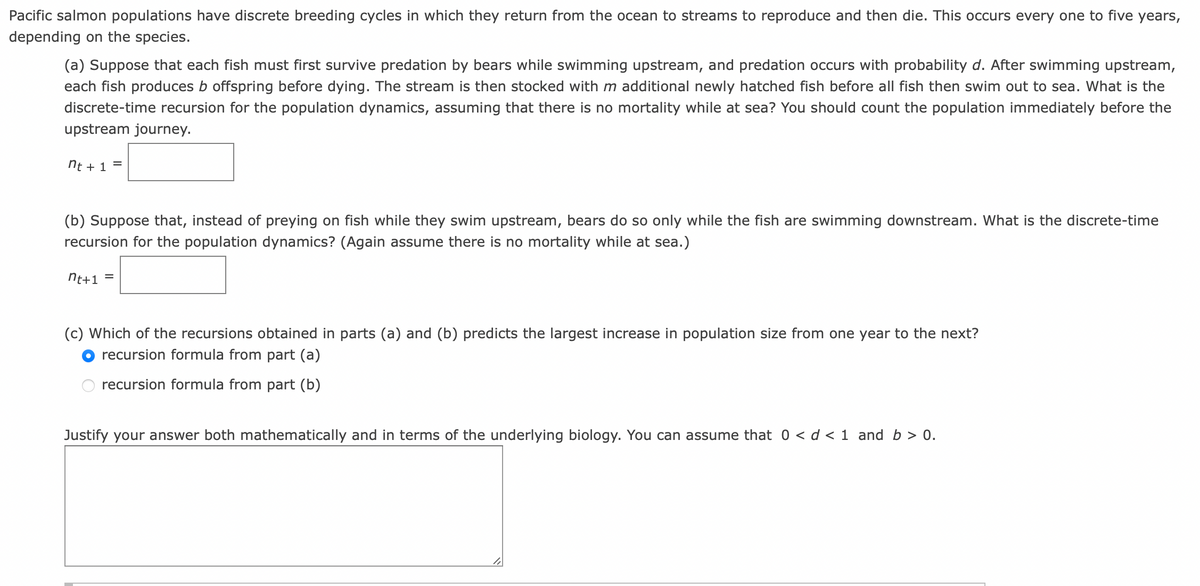Pacific salmon populations have discrete breeding cycles in which they return from the ocean to streams to reproduce and then die. This occurs every one to five years, depending on the species. (a) Suppose that each fish must first survive predation by bears while swimming upstream, and predation occurs with probability d. After swimming upstream, each fish produces b offspring before dying. The stream is then stocked with m additional newly hatched fish before all fish then swim out to sea. What is the discrete-time recursion for the population dynamics, assuming that there is no mortality while at sea? You should count the population immediately before the upstream journey. nt + 1 = (b) Suppose that, instead of preying on fish while they swim upstream, bears do so only while the fish are swimming downstream. What is the discrete-time recursion for the population dynamics? (Again assume there is no mortality while at sea.) nt+1 = (c) Which of the recursions obtained in parts (a) and (b) predicts the largest increase in population size from one year to the next? O recursion formula from part (a) O recursion formula from part (b) Justify your answer both mathematically and in terms of the underlying biology. You can assume that 0 < d < 1 and b > 0.
Pacific salmon populations have discrete breeding cycles in which they return from the ocean to streams to reproduce and then die. This occurs every one to five years, depending on the species. (a) Suppose that each fish must first survive predation by bears while swimming upstream, and predation occurs with probability d. After swimming upstream, each fish produces b offspring before dying. The stream is then stocked with m additional newly hatched fish before all fish then swim out to sea. What is the discrete-time recursion for the population dynamics, assuming that there is no mortality while at sea? You should count the population immediately before the upstream journey. nt + 1 = (b) Suppose that, instead of preying on fish while they swim upstream, bears do so only while the fish are swimming downstream. What is the discrete-time recursion for the population dynamics? (Again assume there is no mortality while at sea.) nt+1 = (c) Which of the recursions obtained in parts (a) and (b) predicts the largest increase in population size from one year to the next? O recursion formula from part (a) O recursion formula from part (b) Justify your answer both mathematically and in terms of the underlying biology. You can assume that 0 < d < 1 and b > 0.
Elementary Linear Algebra (MindTap Course List)
8th Edition
ISBN:9781305658004
Author:Ron Larson
Publisher:Ron Larson
Chapter2: Matrices
Section2.5: Markov Chain
Problem 16E: Consumer Preference In a population of 100,000 consumers, there are 20,000 users of Brand A, 30,000...
Related questions
Question

Transcribed Image Text:Pacific salmon populations have discrete breeding cycles in which they return from the ocean to streams to reproduce and then die. This occurs every one to five years,
depending on the species.
(a) Suppose that each fish must first survive predation by bears while swimming upstream, and predation occurs with probability d. After swimming upstream,
each fish produces b offspring before dying. The stream is then stocked with m additional newly hatched fish before all fish then swim out to sea. What is the
discrete-time recursion for the population dynamics, assuming that there is no mortality while at sea? You should count the population immediately before the
upstream journey.
nt + 1 =
(b) Suppose that, instead of preying on fish while they swim upstream, bears do so only while the fish are swimming downstream. What is the discrete-time
recursion for the population dynamics? (Again assume there is no mortality while at sea.)
nt+1
(c) Which of the recursions obtained in parts (a) and (b) predicts the largest increase in population size from one year to the next?
recursion formula from part (a)
recursion formula from part (b)
Justify your answer both mathematically and in terms of the underlying biology. You can assume that 0 < d < 1 and b > 0.
Expert Solution
This question has been solved!
Explore an expertly crafted, step-by-step solution for a thorough understanding of key concepts.
Step by step
Solved in 4 steps

Recommended textbooks for you

Elementary Linear Algebra (MindTap Course List)
Algebra
ISBN:
9781305658004
Author:
Ron Larson
Publisher:
Cengage Learning

Algebra & Trigonometry with Analytic Geometry
Algebra
ISBN:
9781133382119
Author:
Swokowski
Publisher:
Cengage

Elementary Linear Algebra (MindTap Course List)
Algebra
ISBN:
9781305658004
Author:
Ron Larson
Publisher:
Cengage Learning

Algebra & Trigonometry with Analytic Geometry
Algebra
ISBN:
9781133382119
Author:
Swokowski
Publisher:
Cengage